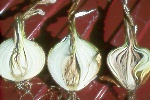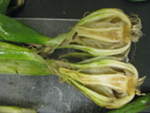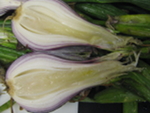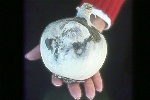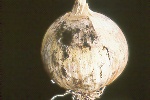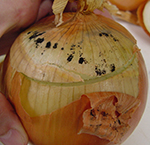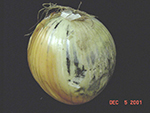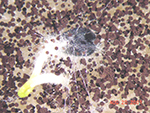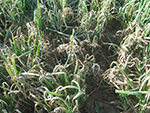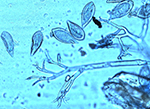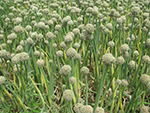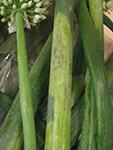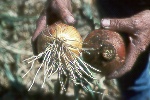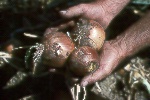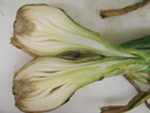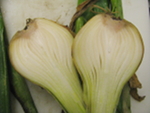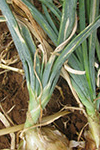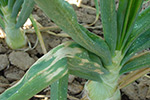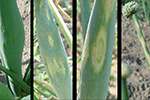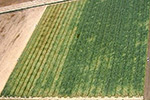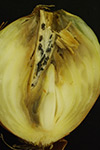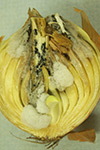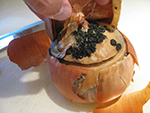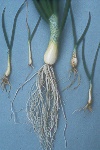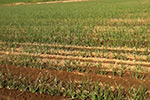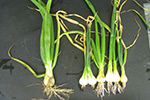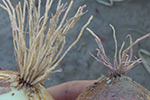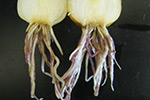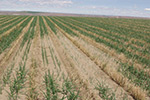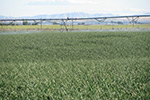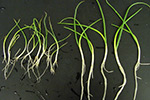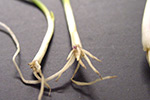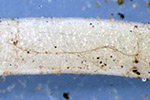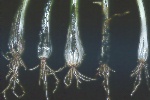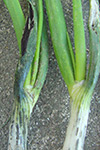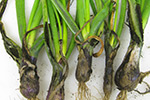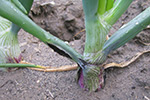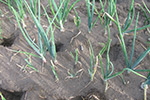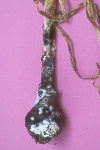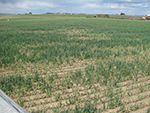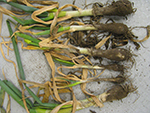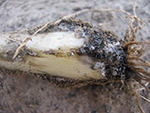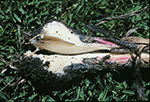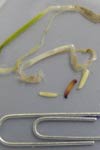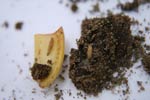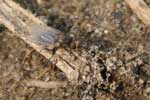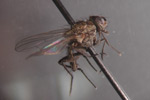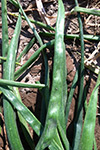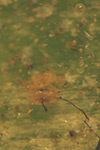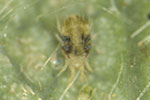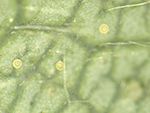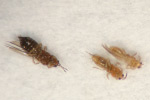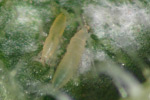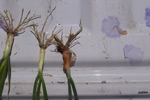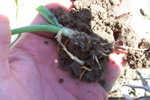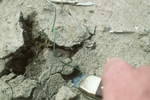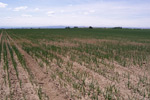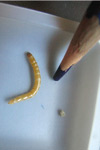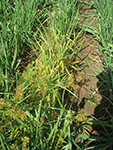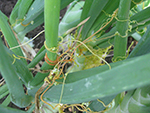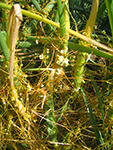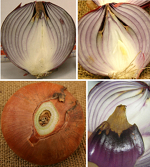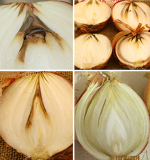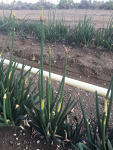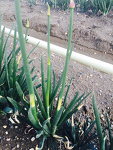Photo Gallery of Vegetable Problems
Onion/Allium
General Onion/Allium Disease and Pest Management |
|||
Diseases |
|||
Insect/Mite Pests |
|||
Weeds |
|||
Abiotic Problems |
|||
| Onion internal dry scale | |||
General Onion/Allium Disease and Pest Management
Onion Disease Guide - A Practical Guide for Seedsmen, Growers and Agricultural Advisors. Published by Seminis Vegetable Seeds, Inc.’s Plant Health Department.
Pest Management Strategic Plan for Dry Bulb Storage Onions in the United States
SCRI Project Updates Talks and Publications, Allium Net.
Onion ipmPIPE Brochure
Onion ipmPIPE Diagnostic Pocket Series
Soil-Borne Diseases
Storage Fungal Diseases
Storm Damaged Onions
Virus Diseases
Onion Disease Risk Assessment
Thrips & Iris yellow spot virus (IYSV) Forecast
Bacterial Disease Forecasts
Fungal Disease Forecasts
(Click on photos to enlarge)
Diseases
Disease: Bacterial soft rot
Pathogen: Bacterial species
| Bacterial soft rot on onion | Internal symptoms of bacterial soft rot of onion bulbs. | ||
Photo Source: G.Q. Pelter |
Photo Source: Lindsey du Toit, Washington State University |
||
On-Line Resources:
Bacterial Diseases, Onion ipmPIPE Diagnostic Pocket Series
Disease: Basal rot
Pathogen: Botytis allii and Fusarium roseum
On-Line Resources:
Onions, Garlic: Basal rot, Washington State University Hortsense
Storage Fungal Diseases, Onion ipmPIPE Diagnostic Pocket Series
Disease: Black mold
Pathogen: Aspergillus niger
On-Line Resources:
Pacific Northwest Plant Disease Management Handbook: Onion (Allium cepa) – Black Mold
Storage Fungal Diseases, Onion ipmPIPE Diagnostic Pocket Series
Disease: Diseases of storage garlic
See: Diseases of Storage Garlic (Oregon State University)
Disease: Downy mildew
Pathogen: Peronospora destructor
On-Line Resources:
Pacific Northwest Plant Disease Management Handbook: Onion (Allium cepa) – Downy Mildew
Foliar Fungal Diseases, Onion impPIPE Diagnostic Pocket Series
Onions, Garlic: Downy mildew, Washington State University Hortsense
Disease: Fusarium basal rot
Pathogen: Fusarium species
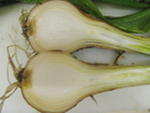 |
| Fusarium basal rot of onion bulbs of the cultivar Gunnison caused by Fusarium oxysporum f. sp. cepae. |
| Photo Source: Lindsey du Toit, Washington State University |
On-Line Resources:
Pacific Northwest Plant Disease Management Handbook: Onion (Allium cepa) – Fusarium Basal Rot
Storage Fungal Diseases, Onion impPIPE Diagnostic Pocket Series
Disease: Iris yellow spot (IYS)
Latin binomial: Iris yellow spot virus (IYSV)
Host Crops: Primarily Allium spp., particularly bulb onion (A. cepa), but a range of common weed species in onion crops has been identified as potential symptomatic and asymptomatic hosts.
On-Line Resources:
Iris yellow spot virus: An Emerging Threat to Onion Bulb and Seed Production
Susceptibility of storage onion cultivars to iris yellow spot in the Columbia Basin of Washington, 2004, L.J du Toit, Washington State University and G.Q. Pelter, Washington State University
Pacific Northwest Plant Disease Management Handbook: Onion (Allium cepa) – Iris Yellow Spot
Disease: Neck rot
Pathogen: Botrytis allii and Botrytis aclada are the two primary species that cause neck rot of onion, although as many as six species of Botrytis can infect various Allium spp.
Host Crops: Onion (Allium cepa) and other Allium spp.
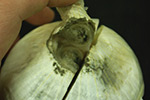 |
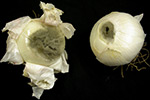 |
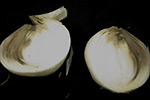 | ||
| Photos of neck rot of onion | ||||
| Photo Source: Jordan Eggers, Oregon State University | ||||
On-Line Resources:
Pacific Northwest Plant Disease Management Handbook: Onion (Allium cepa) – Neck Rot
Important New York Vegetable Diseases: Onion Neck Rot, Vegetable MD Online, Cornell University
Botrytis Neck Rot of Onion, Utah State University Extension
Onion neck rot, The Royal Horticultural Society
Detection and Identification of Botrytis Species Associated with Neck Rot, Scape Blight, and Umbel Blight of Onion, Plant Management Network
A Real-Time, Quantitative PCR Seed Assay for Botrytis spp. that Cause Neck Rot of Onion, Plant Disease, The American Phytopathological Society
Disease: Powdery mildew
Pathogens: Leveillula taurica (synonyms Oidiopsis sicula, O. taurica)
Host crops: This fungus is reported to infect 100’s of plant species, although many strains are host-specific. The disease is favored by high relative humidity during warm weather. The disease typically causes little damage to most onion cultivars in the Pacific Northwest, but symptoms occasionally can be more severe, e.g., in 2004 and 2019 in the inland Pacific Northwest. The disease appears to be most common and severe on cultivars with very glossy leaves, which is associated with thin cuticular waxes.
 |
 |
 |
 |
| Onion powdery mildew | |||
| Photo Source: Stuart Reitz, Oregon State University | |||
Online Resources:
2019 WSU Extension Onion Cultivar Demonstration & Field Day (PDF) Opens in new window , (page 6, shows onion cultivars rated for severity of powdery mildew by Carrie Wohleb, WSU Region Extension Specialist, in the 2019 WSU Onion Cultivar Trial), WSU Extension & the Pacific Northwest Vegetable Association.
Onion (Allium cepa)-Powdery Mildew Opens in new window , by D. H. Gent and C. M. Ocamb, PNW Plant Disease Management Handbook.
Disease: Root rot
Pathogen: Trichodorus and Pythium
On-Line Resources:
Disease: Pink root
Pathogen: Phoma terrestris (Pyrenochaeta terrestris)
Host Crops: Primarily onion, but some strains of the fungus are pathogenic on barley, cantaloupe, carrot, cauliflower, cucumber, eggplant, pea, corn, millet, muskmelon, oat, pepper, ryegrass, sorghum, soybean, spinach, squash, sweet corn, tomato, and wheat.
On-Line Resources:
Pacific Northwest Plant Disease Management Handbook: Onion (Allium cepa) – Pint Root
Soil-Borne Diseases of Onion, Colorado State University Extension
UC Pest Management Guidelines: Onion and Garlic Pink Root, UC IPM Online, University of California
Disease: Rhizoctonia stunting (also known as ‘Mallee’ in Australia after the Mallee region of South Australia, where the disease was first documented in that country)
Causal agent (Latin binomial): Rhizoctonia spp., particularly Rhizoctonia solani (various anastomosis groups, including AG 8). The fungi colonize the roots of winter cover crops planted preceding onion bulb crops. The cover crop is killed with a herbicide application in spring, around the time that onion seed is planted, to provide a physical barrier to protect emerging onion seedlings from wind- and sandblasting on the sandy soils typical of many fields in the Columbia Basin of central Washington and northcentral Oregon. Herbicide is applied to the cover crop to prevent the cover crop from competing with the onion crop. However, this enables Rhizoctonia spp. to colonize the dying roots and crown tissue of the cover crop, building up inoculum that can then colonize onion seedlings.
Host Crops: Onion, pea, cereals, other crops.
On-Line Resources:
Strip-Tillage for Onions and Sweet Corn - Lorin Grigg, Farmer-to-Farmer Case Study Series: Increasing resilience among farmers in the Pacific Northwest, by Georgine Yorgey, Center for Sustaining Agriculture and Natural Resources, Washington State University and Andrew McGuire, Irrigated Cropping Systems Agronomist, Washington State University Extension (PNW702). View on-line or download free PDF.
Stunting of Onion in the Columbia Basin of Oregon and Washington Caused by Rhizoctonia spp. Plant Disease 97:1626–1635.
Effect of timing of glyphosate application to a winter wheat cover crop on stunting of spring-sown onions caused by Rhizoctonia spp. in the Columbia Basin of Washington, 2012, Plant Disease Management Reports 7:V046, 2013.
Efficacy of fungicides to manage onion stunting caused by Rhizoctonia spp. in the Columbia Basin of Oergon and Washington, 2011–2012, Plant Disease Management Reports 7:V047, 2013.
Yield responses of three onion cultivars to stunting caused by Rhizoctonia spp. in the Columbia Basin of Oregon and Washington, 2012. Plant Disease Management Reports 7:V048, 2013.
Rhizoctonia Seedling Blight of Onion and Pea Crops in the Columbia Basin, WSU 2011 Onion Field Day report, Soap Lake, WA, 26 Aug. 2011
Rhizoctonia Seedling Blight of Onion Crops in the Columbia Basin, WSU 2012 Onion Field Day report, Connell, WA, 30 Aug. 2012
Onion Stunting Caused by Rhizoctonia: Management and Economic Importance in the Columbia Basin of Oregon and Washington, Proceedings article from 2012 National Allium Research Conference, Las Cruces, NM, 12–14 Dec. 2012
Disease: Rust
Pathogen: Puccinia allii (= Puccinia porri)
Host Crops: Onion and garlic.
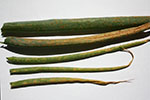 |
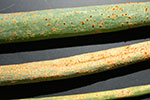 |
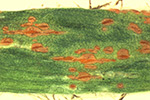 |
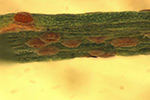 |
|
| Photo Source: Seth Lewis, WSU NWREC Vegetable Pathology program | Photo Source: Johnny Stark, WSU Puyallup PIDL | |||
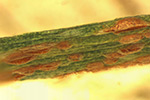 |
|
| Photo Source: Johnny Stark, WSU Puyallup PIDL | |
On-Line Resources:
Pacific Northwest Plant Disease Management Handbook: Onion (Allium cepa) – Rust
Diseases of onion and garlic ( Allium sepa and Allium sativa ) in Arizona: Garlic Rust, University of Arizona
UC Pest Management Guidelines: Onion and Garlic Rust, UC IPM Online, University of California
Prediction of Disease Infection of Welsh Onions by Rust Fungus Based on Temperature and Wetness Duration, IEEEXplore
Disease: Onion Smut
Pathogen: Urocystis colchici (= Urocystis cepulae)
On-Line Resources:
Onion Smut, Identification & Management of Emerging Vegetable Problems in the Pacific Northwest. Pacific Northwest Vegetable Extension Group.
Pacific Northwest Plant Disease Management Handbook: Onion (Allium cepa) – Smut
Efficacy Testing of Onion Seed Treatments in the Greenhouse and Field. Acta Hort. 631 in 2004 by McDonald et al.
Onion disorder: Smut. University of Wisconsin extension bulletin
Disease: White rot
Pathogen: Sclerotinia cepivorum
Host plants: Garlic, onion, and other Allium spp.
On-Line Resources:
Video: Epidemiology and IPM of White Rot in Allium Crops, presented by Dr. Jeremiah Dung, Associate Professor in the Department of Botany and Plant Pathology at the Oregon State University Central Oregon Research and Extension Center, Madras, OR., August 21, 2020.
Pacific Northwest Plant Disease Management Handbook: Onion (Allium cepa) – White Rot
Onions, Garlic: White rot, Washington State University Hortsense
Soil-Borne Diseases, Onion ipmPIPE Diagnostic Pocket Series
Insect/Mite Pests
Common name: Bulb mites/eriophyid mites
Latin binomial: Aceria tulipae, an eriophyid mite, appears most commonly associated with damage to garlic in storage. Various bulb and eriophyid mites can feed on garlic cloves and bulbs of other Allium spp.
Host crops: Various Allium spp. as well as other plants or decaying organic matter. Severe infestations can cause desiccation of bulbs, and mites can vector garlic-rotting fungi.
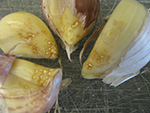 |
 |
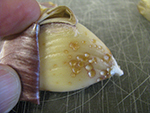 |
| Damage to garlic cloves caused by eriophyid mite feeding. | ||
| Photo Source: Lindsey du Toit, Washington State University | ||
Online Resources:
https://www.science.oregonstate.edu/bpp/Plant_Clinic/Garlic/eriophyids.htm
https://ecoport.org/ep?SearchType=pdb&PdbID=16129
Moth balls (the kind used to keep moths out of stored woolen sweaters) can help control mites in seed garlic, but should not be used for garlic that will be consumed.
Disease: Seedcorn maggot
Pathogen: Delia platura
Host Crops: Many vegetable crops including snap, kidney, and lima beans, onion, corn, turnip, pea, cabbage, and cucurbits. They cause the most damage in spring to newly emerging seedlings.
On-Line Resources:
Pacific Northwest Insect Management Handbook: Vegetable crop pests – Seedcorn maggot
Seed Corn Maggot. VegEdge, University of Minnesota
Seed Corn Maggot. UMass Amherst
See Diseases, pests, and other problems common to many vegetables: Seedcorn maggot
Common name: Two-spotted spider mite
Latin binomial: Tetranychus urticae (= T. bimaculatus = T. telarius).
Host crops: Numerous species of low-growing plants as well as a wide range of shrub and tree species. Normally not a significant pest of onion crops in the Pacific Northwest.
On-Line Resources:
Pacific Northwest Insect Management Handbook. Chapter: Vegetables, Section: Common Pests of Vegetable Crops: Spider mite
Pacific Northwest Insect Management Handbook. Chapter: Supplement 1: Mite ID, Section: Common Mite Pests and Predators – pt. 1
Common name: Thrips, including western flower thrips, onion thrips, and other species.
Latin binomial: Various thrips including Frankliniella occidentalis (western flower thrips) and Thrips tabaci (onion thrips). The latter is also a vector if Iris yellow spot virus (IYSV).
Host crops: Numerous plant species including many vegetables such as basil, broccoli, cabbage, cauliflower, cucumber, onion, potato, pumpkin, squash, tomato and watermelon.
On-Line Resources:
Pacific Northwest Insect Management Handbook. Chapter: Vegetables, Section: Onion pt. 2.
Onion Thrips, Washington State University Extension Fact Sheet, FS126E.
Vegetables: Onions, Garlic: Onion thrips, Washington State University Hortsense.
Western Flower Thrips Thysanoptera: Thripidae Frankiniella occidentalis,
Onion and Garlic Thrips, UC IPM Online, University of California
Life Cycle of Onion Thrips (Thrips tabaci)
See Diseases, pests, and other problems common to many vegetables: Western flower thrips.
Common name (of damaging stage): Wireworm (adults are called click beetles or snapping beetles)
Latin binomial: Ctenicera spp. and Limonius spp. Several kinds of wireworms are in the Pacific Northwest. Wireworms causing the most damage in irrigated areas are the Pacific Coast wireworm (Limonius canus), the sugar beet wireworm (L. californicus), the western field wireworm (L. infuscatus), and the Columbia Basin wireworm (L. subauratus). The Pacific Coast and sugar beet wireworms are the most common. Where annual rainfall is <15 inches, the Great Basin wireworm (Ctenicera pruinina) may be a problem, especially when irrigated crops are grown on sagebrush or dry wheat land. This species usually disappears after a few years of irrigation, but may be replaced by Limonius spp. which are favored by moist conditions. West of the Cascades, other wireworm species are pests, including Agriotes spp.
Host crops: All crops are susceptible to wireworm, but this pest is most destructive on beans, carrot, corn, grain, onion, potatoes, spinach seed crops, and other annual crops in the PNW.
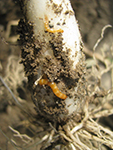 |
 |
 |
 |
| Wireworms feeding on an onion plant in a bunching onion (CFC = cepa fistulosum cross) seed crop. | A click beetle of the species Agriotes obscurus, the larvae of which are wireworms. | A click beetle of the species Limonius californicus, the larvae of which are wireworms. | A click beetle of the species Limonius canus, the larvae of which are wireworms. |
| Photo Source: Lindsey du Toit, Washington State University | Photo Source: Oregon State University – Oregon State Arthropod Collection. | ||
On-Line Resources:
Pacific NorthwestInsect Management Handbook: Vegetable crop pests – Wireworm.
Managing Wireworms in Vegetable Crops. Ontario Ministry of Agriculture and Food
Wireworms. VegEdge, University of Minnesota.
Wireworm Field Guide - A guide to the identification and control of wireworms, Syngenta Crop Protection Canada, Inc.
Wireworm Biology and Nonchemical Management in Potatoes in the Pacific Northwest, N. Andrews, M. Ambrosino, G. Fisher, and S.I. Rondon, Pacific Northwest Extension Publication no. PNW607
See Diseases, pests, and other problems common to many vegetables: Wireworm.
Weeds
Common Name: Dodder
Latin binomial:Cuscuta spp.
Plants affected: Dodder is a parasitic plant that feeds on many other plant species. Dodder cannot photosynthesize, but produces haustoria that penetrate the host plant to absorb water and nutrients. Small, white to cream flowers are produced.
Online Resources:
https://www.ipm.ucdavis.edu/PMG/PESTNOTES/pn7496.html
https://www.colostate.edu/Dept/CoopExt/4DMG/Weed/dodder.htm
https://pnwhandbooks.org/weed/horticultural/vegetable-crops/onions
Common name: Yellow nutsedge
Latin binomial: Cyperus esculentus (Cyperaceae)
Plants affected: Any annual crop; the most seriously affected crops include onion and other plants with a light canopy and narrow range of herbicides available for use.
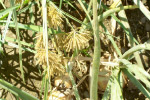 |
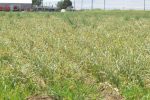 |
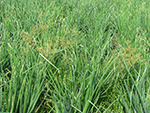 |
| Closeup view of a yellow nutsedge plant/flower. | Severe nutsedge infestation in an onion crop. | Nutsedge in an onion bulb crop. |
| Photo source: Lindsey du Toit, Washington State University |
On-Line Resources:
Yellow Nutsedge. Identification & Management of Emerging Vegetable Problems in the Pacific Northwest, Pacific Northwest Vegetable Extension Group.
Diseases, pests, and other problems common to many vegetables: Yellow Nutsedge.
Abiotic Problems
Problem: Basal plate splitting, basal plate blow-out
Causal agent: Uneven irrigation of onion fields increases the incidence of this disorder. If the soil is repeatedly over-irrigated, dried, and over-irrigated again, onion bulbs are likely to develop split basal plates. The wounding provides an opportunity for secondary microorganisms and bulb mites to colonize the bulbs.
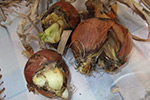 |
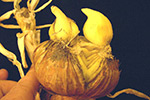 |
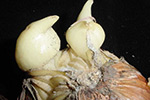 |
| Photo Source: Toni Grove, Whidbey Island Master Gardener | Photo Source: Jenny Glass, Washington State University Plant Diagnostician | |
On-Line Resources:
Abiotic Problem: Onion internal dry scale
Cause: The exact cause of onion internal dry scale remains to be verified, but the problem is most prevalent and severe in onion bulb crops harvested after summers with extreme periods of heat stress, e.g., in 2014 and 2015 in the Columbia Basin of Washington/Oregon and the Treasure Valley of Oregon. Several dry, internal, fleshy scales in the developing bulb collapse in the upper part of the bulb, either partially or completely. The dry scales can readily be colonized by bacteria, fungi, or yeasts which may lead to development of bulb rots.
Online Resources:
Internal Dry Scale and Associated Bulb Rots of Onion. A common problem was observed in the 2014–2015 season and the 2015–2016 onion-growing season on red, white, and yellow cultivars—internal dry scale. Careful monitoring of crop moisture demand to increase our understanding of onion physiology, particularly close to harvest, will help in the development of effective management practices to reduce the impact of internal dry scale on this important region of onion production.
Herbicide Injury
Problem: Herbicide injury
Causal agent: Onion and other Allium spp. can be injured by herbicides, e.g., as a result of drift of herbicides from nearby crops, from residual carryover effects when onions are planted into soil treated with herbicides from a previous crop, or from direct contact injury.
Online Resources:
Herbicide Symptoms, University of California, Division of Agriculture and Natural Resources
Herbicide Modes and Action and Symptoms on Plants, Richard Smith, Farm Advisor, University of California Cooperative Extension.
Our pages provide links to external sites for the convenience of users. WSU Extension does not manage these external sites, nor does Extension review, control, or take responsibility for the content of these sites. These external sites do not implicitly or explicitly represent official positions and policies of WSU Extension.

